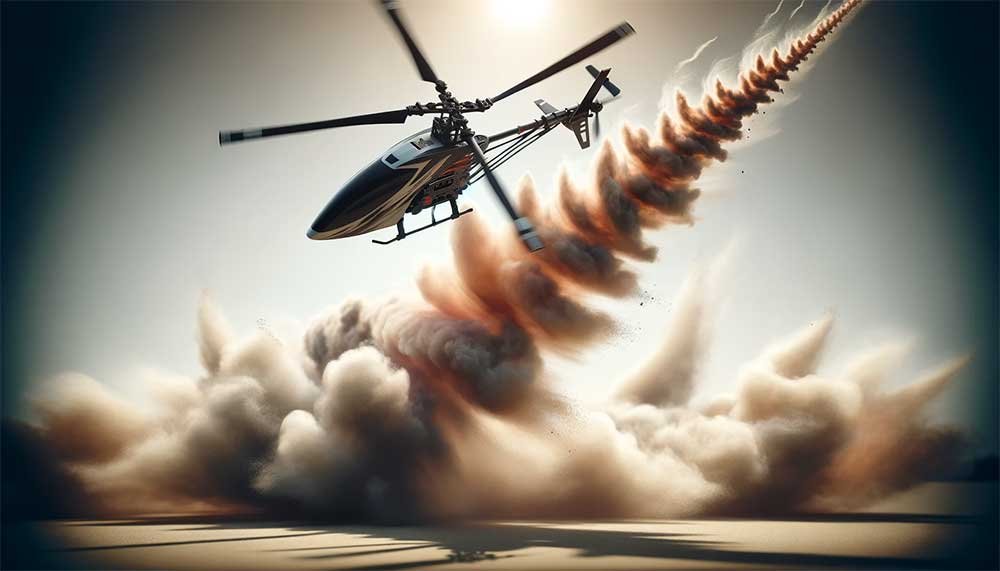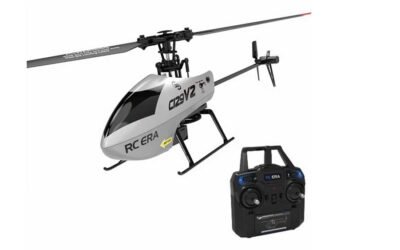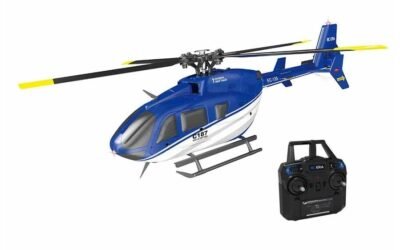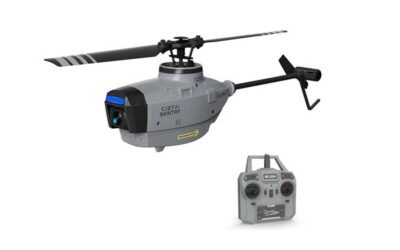The Ultimate Guide to 6-Channel RC Helicopters
The key to flying 6-channel RC helicopters is mastering the basics: understanding controls, practicing hovering and turns, and gradual skill advancement. Perfect for beginners and hobbyists
“The sky is not the limit, it’s just the beginning for RC pilots.”

Section 1: The Thrilling World of RC Helicopters
Unleashing the Fun: An Introduction
Remote control (RC) helicopters are a fascinating blend of technology and entertainment, capturing the imagination of hobbyists and aviation enthusiasts alike. These miniature marvels, controlled from the ground using a handheld transmitter, offer a unique experience in maneuverability and precision. From the earliest, more rudimentary models to today’s sophisticated versions, RC helicopters have undergone a remarkable evolution.
Initially, RC helicopters were basic, often with limited controls and functionalities. They were primarily used for leisure, with a focus on ease of use rather than technical prowess. However, as technology advanced, so did these nimble flyers. The introduction of additional channels allowed for greater control and more complex maneuvers, transforming these simple toys into intricate machines capable of performing awe-inspiring aerobatics.
Why 6-Channels? The Game-Changer in Remote Control Aviation
The term ‘channel’ in RC helicopters refers to the number of functions that the pilot can control. Each channel represents a specific function, such as throttle, pitch, yaw, and roll. In simpler 3 and 3.5 channel models, the controls are basic, often limited to up/down, left/right, and forward/backward movements. These models are great for beginners but offer limited agility and control.
As we move to 4-channel helicopters, the complexity increases, introducing more freedom in movement and better stability. However, it is the 6-channel RC helicopters that truly revolutionize the experience. These advanced models offer unparalleled control, allowing pilots to maneuver their helicopters with a level of precision that closely mimics real-life helicopters. They can fly backwards, sideways, and even perform inverted flights, offering a more immersive and challenging experience.
This significant leap from lower channel models to 6-channel helicopters marks a shift from simple flying toys to sophisticated flying machines. It opens up a world of possibilities for RC enthusiasts, allowing for more dynamic flying styles and intricate aerial tricks. Whether you’re a seasoned pilot or a curious beginner, the world of 6-channel RC helicopters promises excitement and challenge, elevating the RC flying experience to new heights.
Section 2: Diving Deep into the 6-Channel Experience
Technical Tango: Understanding the Mechanics
The world of 6-channel RC helicopters is a mesmerizing dance of technology and skill. These models are the Ferraris of the RC helicopter world, boasting a complexity that demands both respect and understanding.
Technical Specifications: 6-channel helicopters are equipped with a 6-axis gyro stabilization system, offering superior stability and responsiveness. They typically feature a collective pitch (CP), allowing pilots to control the lift by varying the angle of the rotor blades. This enables advanced maneuvers like hovering, flipping, or even inverted flight.
The power system in these models is equally impressive. Most use brushless motors, known for their efficiency and power. The battery life, usually a high-capacity Li-Po (Lithium Polymer) battery, offers extended flight times and robust performance.
Translating Tech into Performance: These technical advancements are not just for show. They translate into a flying experience that is thrillingly responsive and agile. The collective pitch control allows for rapid changes in altitude and direction, making these helicopters ideal for aerobatics and precision flying.
Maneuvering Mastery: The Art of Flying a 6-Channel
Flying a 6-channel RC helicopter is like playing a violin; it requires finesse, practice, and a touch of flair.
The Learning Curve: Newcomers to 6-channel helicopters should brace themselves for a steep learning curve. Unlike their 3 or 4-channel counterparts, these models require a more nuanced understanding of flight dynamics. The additional channels add complexity but also provide a more realistic flying experience.
Tips for Beginners:
- Start with a Simulator: Before taking to the skies, practice on a flight simulator. This can help you get a feel for the controls without risking your helicopter.
- Gradual Progression: Begin with basic maneuvers like hovering and simple forward flight. As your confidence grows, gradually introduce more complex moves.
- Steady Does It: Smooth, controlled movements are key. Overcorrecting can lead to instability and crashes.
Advanced Pilot Tricks:
- Inverted Flight: Once you’re comfortable, try flying upside down. This will test your skills and understanding of the controls.
- The Funnel: A challenging maneuver where the helicopter flies in a circular path with its nose pointing towards the center of the circle.
- The Tick-Tock: This involves rocking the helicopter back and forth while maintaining altitude, resembling the movement of a clock’s pendulum.
Safety First: Remember, with great power comes great responsibility. Always fly in a safe, open area and be mindful of your surroundings.
In summary, 6-channel RC helicopters offer a gateway into a world of high-octane aerial acrobatics and precision flying. Whether you’re a novice getting your rotor blades spinning or an experienced pilot performing breathtaking stunts, the journey promises to be as rewarding as it is challenging. So, strap in, throttle up, and get ready for an adventure that takes RC flying to new heights – literally!

Section 3: Choosing Your Wingman
The Market’s Best: Top 6-Channel Helicopters Reviewed
Selecting the right 6-channel RC helicopter is like choosing a dance partner for an aerial ballet. With so many options on the market, it’s essential to know which models stand out. Here, we’ll review some of the top contenders, highlighting their features and what makes them the crème de la crème of the RC world.
Model A:
- Features: Boasting a state-of-the-art gyro stabilization system and a robust brushless motor, Model A is the epitome of precision and power. Its lightweight design, coupled with a high-capacity Li-Po battery, offers extended flight times and impressive agility.
- User Experience: Pilots rave about its responsive controls and stability, making it a top pick for both beginners and seasoned enthusiasts. Its durability is also a key highlight, capable of surviving the occasional rough landing.
Model B:
- Features: Model B steps up the game with its advanced flight control system and customizable settings. Its unique design includes an innovative rotor mechanism that provides exceptional control and maneuverability.
- User Experience: This model is a favorite among advanced pilots who enjoy tweaking settings for a personalized flight experience. The learning curve is steeper, but the rewards are unparalleled in terms of performance and aerial acrobatics.
Model C:
- Features: Integrating cutting-edge technology, Model C offers a seamless blend of user-friendliness and advanced capabilities. It features GPS-assisted hovering and an automatic return-to-home function, making it a foolproof option for new pilots.
- User Experience: The standout for Model C is its ease of use, making it a great starting point for those venturing into 6-channel territory. Its safety features are a big plus, providing peace of mind for those still mastering the art of flight.
Feature Face-Off: Comparing Models
To provide a clearer picture, let’s put these models side by side in a table comparison. We’ll also look at how they stack up against lower channel models.
|
Feature |
3-Channel |
3.5-Channel |
4-Channel |
6-Channel (Model A, B, C) |
|
Control Complexity |
Basic |
Basic+ |
Intermediate |
Advanced |
|
Maneuverability |
Limited |
Slightly Improved |
Good |
Excellent |
|
Stability |
Moderate |
Good |
Very Good |
Exceptional |
|
Flight Capabilities |
Basic Movements |
Enhanced Stability |
Rolls and Loops |
Inverted Flight, 3D Aerobatics |
|
Ideal for |
Beginners |
Beginners+ |
Intermediate Users |
Advanced Users |
Choosing Based on User Needs and Skill Levels:
- Beginners: If you’re just getting your rotor blades wet, start with a 3 or 3.5-channel helicopter. They offer a gentle introduction to RC flying without overwhelming you.
- Intermediate Pilots: Ready to level up? A 4-channel model provides a nice bridge, introducing more complex controls and maneuvers without the full complexity of a 6-channel.
- Advanced Pilots: For those who dream of dizzying heights and breathtaking aerobatics, a 6-channel helicopter is your ticket. Choose based on specific features like GPS, gyro stabilization, and battery life that align with your flying aspirations.
In conclusion, whether you’re a rookie pilot or an aspiring RC ace, there’s a perfect wingman out there for you. Remember, it’s not just about the specs; it’s about finding a helicopter that resonates with your style and elevates your flying experience. So, take your time, do your research, and get ready to soar into the thrilling world of 6-channel RC helicopters!

Section 4: Beyond Just Flying – The Bigger Picture
Community and Competitions: Joining the RC Helicopter Frenzy
When it comes to RC helicopters, it’s not just about the solo flight; it’s about the community and the competitive spirit that fuels this hobby.
The Vibrant RC Helicopter Community:
- Online Forums and Social Media: The digital age has brought pilots together from around the globe. Online forums are buzzing hives of activity where enthusiasts share tips, showcase their latest flights, and discuss everything from beginner queries to advanced technical advice. Social media platforms, with their groups and pages dedicated to RC helicopter fans, serve as a fantastic medium for sharing videos, engaging in discussions, and staying updated on the latest trends.
- Local Clubs: Joining a local RC helicopter club can be a game-changer. It’s not just about flying together; it’s about learning from each other, sharing experiences, and fostering a sense of community. These clubs often have experienced pilots who are more than willing to mentor newcomers, making the journey into this hobby less daunting and more enjoyable.
Competitions: The Ultimate Challenge:
- Local and National Competitions: For those who love a challenge, RC helicopter competitions are the perfect arena to showcase your skills. These events range from local meetups to national championships, offering categories for different skill levels.
- International Championships: At the pinnacle are the international championships, where the best pilots from around the world compete. These events are not just about winning; they’re about witnessing some of the most breathtaking maneuvers and learning from the elite in the field.
Maintenance and Upkeep: Keeping Your Helicopter High and Dry
A well-maintained helicopter is a happy helicopter. Regular maintenance not only keeps your machine in top flying condition but also extends its lifespan.
Routine Checks:
- Pre-Flight Inspection: Before each flight, do a quick check. Ensure all screws are tight, the battery is secure, and there are no visible damages.
- Post-Flight Maintenance: Clean your helicopter after every session. Check for any wear and tear, especially on the rotor blades and gears.
Repairs and Upgrades:
- DIY Repairs: Learning to do your repairs is part of the RC helicopter experience. From replacing a rotor blade to soldering a loose wire, these skills come in handy and can save you time and money.
- Upgrades for Performance: Upgrading parts like motors, batteries, or even the entire rotor assembly can enhance performance. However, ensure that any upgrades are compatible with your model.
Storage Tips:
- Proper Storage: Store your helicopter in a cool, dry place. If you’re not going to fly it for an extended period, remove the battery and store it separately.
In conclusion, the world of 6-channel RC helicopters is more than just a hobby; it’s a community, a competitive sport, and a journey in mechanical mastery. By engaging with the community, participating in competitions, and diligently maintaining your helicopter, you elevate your experience from merely flying a model to being an integral part of an exciting and dynamic world. So, gear up, both your helicopter and your enthusiasm, and dive into the bigger picture of RC helicopter flying!
Section 5: The Future of Flight: Emerging Trends in RC Helicopters
Technological Triumphs: What’s Next for RC Helicopters?
The RC helicopter industry is not just hovering; it’s soaring to new heights with technological advancements that promise to revolutionize how we engage with these thrilling machines.
Advancements in Flight Control and Stability:
- AI and Machine Learning: Imagine helicopters that learn from each flight, adjusting to environmental conditions and pilot preferences. AI integration is set to offer smarter, more intuitive control systems.
- Advanced Gyroscopes and Stabilization: Future models are expected to include gyroscopes with enhanced sensitivity, allowing for unprecedented stability and control, making them more accessible to beginners and providing a more refined experience for advanced pilots.
Enhanced Connectivity and Control:
- Long-Range Control Systems: We’re looking at technology that could extend the range of control far beyond current standards, opening up possibilities for longer flights and more explorative missions.
- Integration with Wearable Technology: Picture controlling your RC helicopter with smart gloves or even using VR headsets for a first-person view (FPV) experience, taking immersion to a whole new level.
Improved Power Systems and Efficiency:
- More Efficient Batteries: Battery technology is advancing rapidly. Future RC helicopters might see much longer flight times per charge, thanks to high-density, efficient batteries.
- Solar-Powered Helicopters: There’s potential for solar-powered models that would extend flight times and reduce the need for frequent recharging.
Eco-Friendly Flying: The Shift to Sustainable Models
As the world becomes more environmentally conscious, the RC helicopter industry is not far behind.
Biodegradable Materials and Eco-friendly Designs:
- Sustainable Manufacturing: The use of biodegradable materials for body and parts manufacturing is on the horizon. These sustainable models would not only reduce environmental impact but also offer lighter and more efficient designs.
- Recycling Old Models: Initiatives to recycle or upcycle older models could become more prevalent, encouraging hobbyists to be more eco-conscious.
Energy Efficiency and Renewable Energy:
- Efficient Motor Designs: Expect to see more efficient motor designs that consume less power without compromising on performance.
- Renewable Energy Sources: As mentioned, solar power is a big contender, but wind and even piezoelectric energy (generated from vibrations during flight) could play a role in powering future models.
In conclusion, the future of RC helicopters is as exciting as it is innovative. From AI-enhanced flight controls to eco-friendly designs, these advancements are set to redefine the boundaries of what’s possible in remote-controlled flight. Not only will these innovations make RC flying more accessible and enjoyable, but they’ll also ensure it aligns with the growing demand for sustainability and environmental responsibility. So, strap in – the future of RC helicopters is gearing up to be a fantastic blend of technology, thrill, and responsibility!

Key Takeaway Points
| Key Points | Description |
| Control Understanding | Familiarize with the remote control layout and functions. |
| Flight Practice | Start with basic hovering and simple maneuvers, then progress. |
| Safety Measures | Practice in open areas and use simulators for safety. |
| Unique Features | 6-channel helicopters offer advanced controls and aerobatics. |
Section 6: Final Takeoff
Wrapping Up the Flight
As we prepare to land this comprehensive guide on 6-channel RC helicopters, let’s take a moment to recap the high-flying points and prepare you for your own journey into the exhilarating world of advanced RC aviation.
The Journey Through the World of 6-Channel RC Helicopters:
- We started our adventure with an introduction to RC helicopters, tracing their evolution from simple toys to the sophisticated 6-channel models that offer unparalleled control and agility.
- Understanding the mechanics was our next stop, where we delved into the technicalities of 6-channel helicopters, revealing how their intricate features translate into superior performance.
- In choosing your wingman, we reviewed the top models on the market, offering insights on their features and helping you compare them with their less complex counterparts.
- We then explored the bigger picture, highlighting the vibrant community and the importance of maintenance and upkeep in extending the life and performance of your helicopter.
- Our penultimate chapter focused on emerging trends and the future of flight, where we envisioned the technological advancements and the shift towards sustainability in RC helicopters.
Embarking on Your 6-Channel RC Helicopter Journey: As you stand at the threshold of this fascinating hobby, remember that every expert was once a beginner. Here are a few parting thoughts to inspire and guide you:
- Start Where You Are: Don’t be intimidated by the complexity of 6-channel helicopters. Everyone starts somewhere, and there’s a wealth of resources and a supportive community to help you along the way.
- Embrace the Learning Curve: The journey is as rewarding as the destination. Each flight is an opportunity to learn and improve.
- Join the Community: Engage with local clubs and online forums. The shared experiences, tips, and friendships you’ll gain are invaluable.
- Keep an Eye on the Future: As technology evolves, so will the capabilities of RC helicopters. Stay curious and open to new advancements.
- Fly Responsibly: Always be mindful of safety and the regulations in your area.
In conclusion, the world of 6-channel RC helicopters is a dynamic and rewarding hobby that offers endless opportunities for learning, community, and fun. Whether you’re a novice pilot or an aspiring aerial acrobat, there’s a place for you in this sky-high hobby. So, grab your transmitter, power up your rotors, and get ready to take flight into the captivating realm of RC helicopters. The sky’s not the limit; it’s just the beginning!
FAQs
Q1: What are the basic skills needed for flying a 6-channel RC helicopter?
- Understanding the remote control layout.
- Mastering hovering and basic flight maneuvers.
- Gradually advancing to more complex techniques.
Q2: How can beginners practice safely with 6-channel RC helicopters?
- Start in an open, obstacle-free area.
- Use a flight simulator for initial practice.
- Gradually progress from simple to complex maneuvers.
Q3: What makes 6-channel RC helicopters unique in flying experience?
- Advanced control options for precise maneuvers.
- Capability for aerobatics and inverted flight.
- Enhanced responsiveness compared to lower-channel models.

You may be interested in an Advanced Digital Gyroscope
Don’t miss out on the thrill of piloting your own sky adventure – RC Helicopter City offers an exhilarating blend of skill, precision, and fun, perfect for both beginners and seasoned enthusiasts. Embrace the joy of flight today and experience the unmatched excitement of controlling your very own high-performance RC helicopter, a hobby that promises endless hours of entertainment and skill development.
You May Also Like
Related Posts
RC ERA C129 V2 Review: What Makes It Stand Out
Explore the RC ERA C129 V2’s advanced features, its suitability for beginners, and how it’s revolutionizing remote-controlled flight.
Why Choose RC ERA C187 for Your Hobby
Explore the exciting world of the RC ERA C187 Helicopter. This guide offers tips, reviews, and techniques for beginners and pros alike.
RC ERA C127AI Review: Tech Specs and User Feedback
Explore the revolutionary RC ERA C127AI with advanced tech, user-friendly features, and expert reviews. Learn why it’s the top choice for RC enthusiasts.




0 Comments